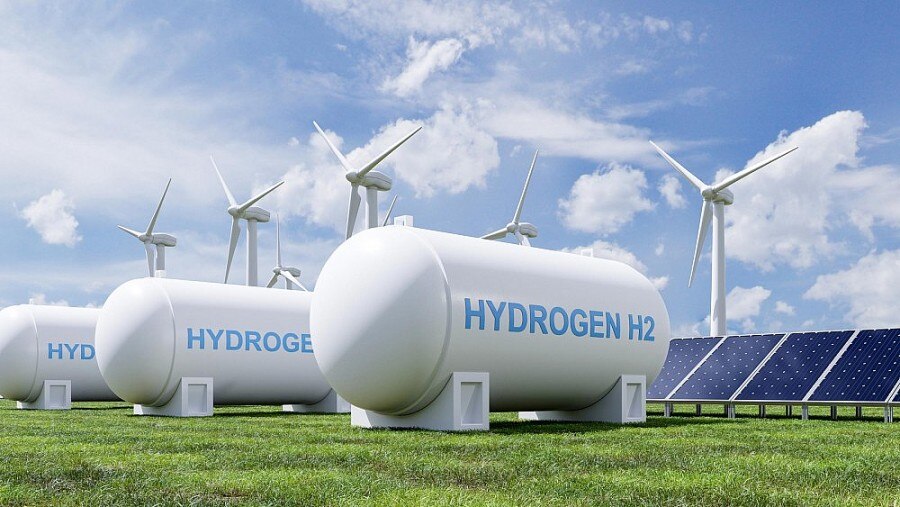At the COP26 Climate Summit held in Glasgow, Scotland, Vietnam, along with many other countries worldwide , committed to achieving net zero emissions by 2050. To achieve this goal, many experts believe that green hydrogen is one of the key solutions.
Green hydrogen is hydrogen produced by electrolyzing water using electricity generated from renewable energy. This process produces only hydrogen and oxygen. We can use the hydrogen and release the oxygen into the atmosphere without any negative impact. This is one of the cleanest ways to produce hydrogen, which can then be used as fuel.
Green hydrogen is very useful in combating climate change because it can replace fossil fuels in applications where decarbonization is complex, such as maritime and aviation transport or certain industrial processes. Furthermore, it has great potential as a seasonal (long-term) energy storage system, capable of accumulating energy over extended periods and then using it as needed.

Many experts believe that green hydrogen is one of the key solutions for Vietnam to fulfill its commitment to achieving net-zero emissions by 2050 at COP 26.
Experts from UNDP in Vietnam noted that the Vietnamese government has recognized the potential impact of climate change and is making efforts to implement solutions through its commitment to achieving net-zero emissions by 2050 at COP26, along with a fourfold increase in solar and wind power capacity since 2019. Simultaneously, the announcement of a $15.5 billion Just Energy Transition Partnership (JETP) with a consortium of international partners, and representatives from several other partners, further highlighted the importance of this initiative.
However, Vietnam needs to make good use of effective alternative energy sources, including green hydrogen from solar and wind power. Green hydrogen is considered a carbon-free energy source that can store energy and then release it in a controlled manner elsewhere, similar to lithium-ion batteries.
Dr. Pham Duy Hoang, a research expert at the Vietnam Energy Transition Initiative (VIETSE), shared: “Vietnam has the potential to develop green hydrogen from abundant renewable energy sources. Green hydrogen is clean energy that can replace fossil fuels currently used in some industrial and transportation sectors, contributing to the energy transition. Developing the green hydrogen industry in the future will not only contribute to the goal of reducing greenhouse gas emissions but also help Vietnam move towards a low-carbon economy .”

Producing green hydrogen from solar cells. (Photo: nghenhinvietnam)
However, to date, Vietnam has not announced specific targets or plans for the development of green hydrogen. Based on emission reduction targets for various sectors, economic efficiency, technological readiness, and corresponding infrastructure in Vietnam, the Vietnam Energy Transition Initiative (VIETSE) has developed three hydrogen development scenarios.
Specifically, Scenario 1 (the current policy scenario) is calculated based on government policies regarding emission reduction roadmaps in each industry, transportation, and energy sector; Scenario 2 (the technology lag scenario) is calculated based on global technology development trends, Vietnam's capabilities, and domestic market demand; Scenario 3 (the acceleration scenario) sets the ambitious goal for Vietnam to keep pace with technological development and have sufficient domestic capacity to produce hydrogen to meet domestic demand and for export.
Accordingly, by 2050, Vietnam will have an annual demand of 58.3 million tons of clean hydrogen (current policy scenario); 4.4 million tons of clean hydrogen (technology lag scenario); and 9.17 million tons of clean hydrogen (acceleration scenario). Experts attending the seminar pointed out that the hydrogen demand in the current policy scenario is higher than the supply capacity outlined in the draft National Energy Plan. For Vietnam, green hydrogen should be prioritized for use in industrial production (fertilizers, oil refining, steel, cement), transportation (long-haul trucks, passenger vehicles, maritime and aviation transport), energy (flexible power generation), and for export.
To promote the development of green hydrogen by 2030, experts suggest that Vietnam needs to develop policies, regulations, and guidelines for green hydrogen development; implement pilot projects; and simultaneously develop policies to encourage the production and use of green hydrogen; develop infrastructure and supply chains. Technical standards and safety guidelines for the production, storage, and transportation of hydrogen should also be established.
Ngoc Chau





















































































































Comment (0)